
Narayana Guru, IPA: [n̪ɐːɾɐːjɐɳɐ guɾu], was a philosopher, spiritual leader and social reformer in India. He led a reform movement against the injustice in the caste-ridden society of Kerala in order to promote spiritual enlightenment and social equality.

The Kerala model of development refers to the economic practices adopted by the Indian state of Kerala. It is characterised by results showing strong social indicators when compared to the rest of the country such as high literacy and life expectancy rates, highly improved access to healthcare and low infant mortality and birth rates. Despite having a lower per capita income, the state is sometimes compared, at all metrics, to developed countries. These achievements along with the factors responsible for such achievements have been considered characteristic results of the Kerala model.
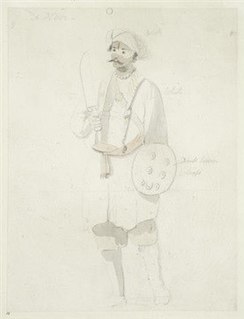
The Nair, also known as Nayar, are a group of Indian Hindu castes, described by anthropologist Kathleen Gough as "not a unitary group but a named category of castes". The Nair include several castes and many subdivisions, not all of whom historically bore the name 'Nair'. These people lived, and continue to live, in the area which is now the Indian state of Kerala. Their internal caste behaviours and systems are markedly different between the people in the northern and southern sections of the area, although there is not very much reliable information on those inhabiting the north.

Indian feudalism refers to the feudal society that made up India's social structure until the Mughal Dynasty in the 1500s. The Guptas and the Kushans played a major role in the introduction and practice of feudalism in India, and are examples of the decline of an empire caused by feudalism.

Māmānkam or Māmāngam was a duodecennial medieval fair held on the bank, and on the dry river-bed, of Pērār at Tirunāvāya, southern India. The temple associated with the festival was Nava Mukunda Temple in Tirunavaya. It seems to have begun as a temple festival, analogous to the Kumbha Melas at Ujjaini, Prayaga, Haridwar and Kumbakonam.
The caste system in Kerala differed from that found in the rest of India. While the Indian caste system generally modeled the four-fold division of society into Brahmins, Kshatriyas, Vaishyas and Shudras, in Kerala, the Nambudiri Brahmins formed the priestly class and only rarely recognized anyone else as being other than Shudra or untouchables, the latter being outside the caste system entirely. Thus, the Kerala caste system was ritualized but it was not the varna model found elsewhere. In Southern India, only in Kerala did there appear warrior lineages approximate to the Kshatriya model.These warriors never lost their identity as sudras.
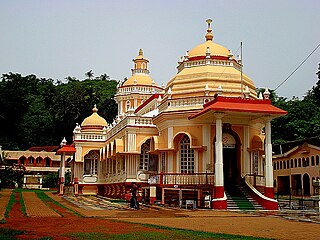
Kula-dèvatā (transl. clan-deity), also known as Kuladeva or Kuladevi is an ancestral tutelary deity in Hinduism, who is often the object of one's devotion (bhakti) in order to coax the deity to watch over one's clan (kula), family and children from misfortune. This is distinct from ishta-devata and village deities.
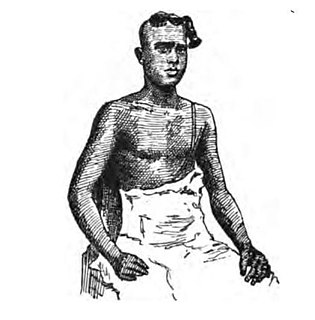
The Nambudiri, also transliterated as Nampoothiri, Nambūdiri, Namboodiri, Nampoothiri, and Nampūtiri, NampiThiru, are a Malayali Brahmin caste, native to what is now the state of Kerala, India.
Padmanabhan Palpu LMS, DPH (Cantab) FRIPH (London) was the second public health doctor in Travancore and a social revolutionary, who become the chief medical officer of Mysore State. He was a member of the British Medical Council for Virology. Ritty Lukose describes him as the "political father" of the Ezhavas, who are numerically the largest caste in the region now encompassed by the state of Kerala. In 1903, he founded the Sree Narayana Dharma Paripalana Yogam, whose first president was Narayana Guru, who sought an end to the caste system and preached his concept of "one caste, one religion, one god."
Panicker is a title or last name. Panicker is an ethnic group belonging to the Hindu religion, who live in the South Malabar and central parts of the Indian state of Kerala. They were well known as the masters of Kalari tradition, having their Nalpatheeradi Kalari. They are the people who propagated and practised Kalaripayattu, the martial art form of Kerala.

Manalur is a small village in Thrissur district of Kerala state, south India. It is one of the constituencies in Thrissur district.

The Ezhavas are a community with origins in the region of India presently known as Kerala, where in the 2010s they constituted about 23% of the population and were reported to be the largest Hindu community. They are also known as Ilhava, Irava, Izhava and Erava in the south of the region; as Chovas, Chokons and Chogons in Central Travancore; and as Thiyyar, Tiyyas and Theeyas in the Malabar region. Some are also known as Thandan, which has caused administrative difficulties due to the presence of a distinct caste of Thandan in the same region. The Malabar Ezhava group have claimed a higher ranking in the Hindu caste system than do the others, although from the perspective of the colonial and subsequent administrations they were treated as being of similar rank.
Ambalavasi, lit. 'temple-dwelling', is a generic name for a group of castes among Hindus in Kerala, India, who render temple services. Some Ambalavasi castes are patrilineal, while the others are matrilineal. Those that practise matrilineality share many cultural similarities with the Nair caste. Their ritual rank in Hinduism lies between the Brahmin castes and the Nairs.

T. M. Varghese (1886–1961) was an India freedom fighter, lawyer, statesman, former minister and politician from Kerala.
Kadayanickadu is a village situated 11 km east of Karukachal, spread out on either sides of Changanacherry - Manimala road in Kerala, India. It is a typical Kerala rural settlement with the nature's green covering, ringing rivulets, small hills and slopes, agricultural fields, inhabited by rustic population. It is a Kara in Vellavoor revenue village in Changanacherry taluk, Kottayam district.
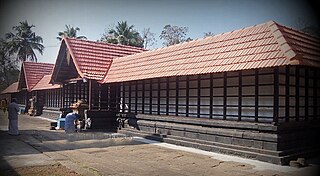
Thumpamon Vadakkumnatha Temple is an ancient temple near Pandalam in Kerala, India. This temple has two Sreekovils. Both Sreekovils are round (vatta). It is an age old temple whispering several fascinating legendary fables of the bygone eras.
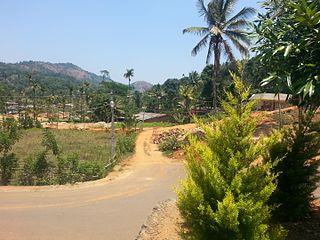
Thankamany is a village at Idukki district, in Kerala state, India. There is a small town associated with this village. In regional language thankamany is a name of a lady. It is a belief that an older jungle king Thopran gave dowry as land for his three daughters Thankamony, Kamashi, and Neeli. The place got for Thankamony is now known as Thankamony, other nearby places are also known as Kamashi and Neelivayal. Thankamany town is located in a valley of three small hills Thamprankunnu, Kattadikavala and Kurishupara respectively. One of the interesting thing is that, even though Kamashi is a different place, the panchayath of thankamany is called Kamashy panchayath and the office is situated in the middle of thankamany town.Sometimes in official documents thankamony is also written as thankamony. Nearest towns are Kattappana and Nedumkandam.

The population of Kerala, India is a heterogenous group that comprises many ethnic groups that originated in other parts of India as well as the world, with distinctive cultural and religious traditions. While the majority of Keralites speak the Malayalam language, various ethnic groups may speak other languages as well.
The total population of the Nair community is disputed, since there has been no caste-based census since 1931. The administrators of the British Raj had an abiding interest in ethnography but in post-independence India the policy has been generally to ignore it in censuses.

Āśān is a Malayalam and Tamil surname and title that means teacher or guide.















